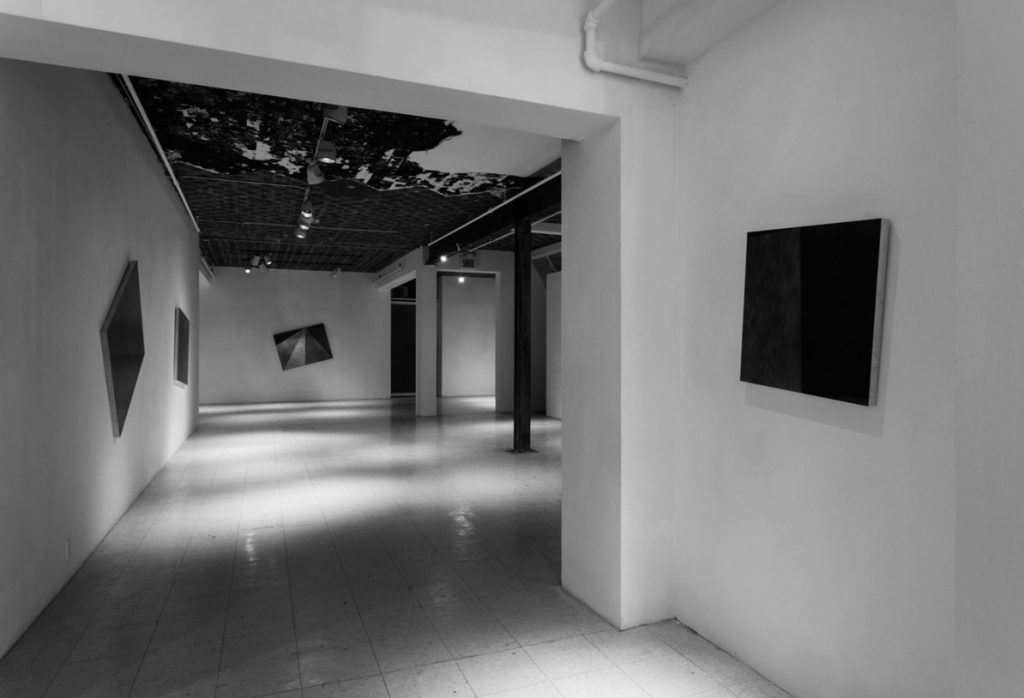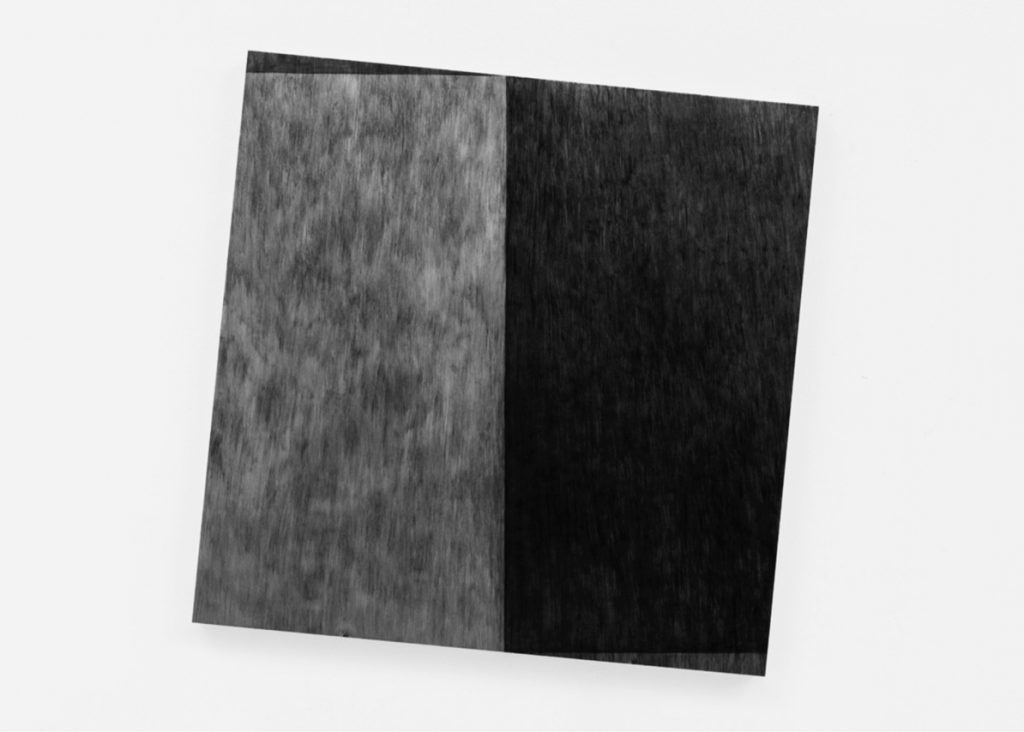A Matter of Perspective
Jinny Yu: Why does its lock fit my key?
Art Mûr, Montreal
03.11.18 – 20.12.18
One’s first experience of Jinny Yu’s current exhibition is a dangerous one. The exhibition’s title, Why does its lock fit my key?, appears on the gallery window in black vinyl letters. Behind it, the title reappears in the same size and font in white letters against a black text box, hand-painted by the artist on a wall in shallow relief of the window. The perfect eclipse of white letters by black can’t be seen from the sidewalk; the viewer must stand in the street. As the viewer calibrates their physical location – and, as I did, dodge traffic – to find this sweet spot, they come to realise the tightness of this single position to be extremely limiting, in the many other possible positions that it occludes.
Why does its lock fit my key? continues Yu’s recent exploration of the subjectivities of contemporary political discourse through deceptively economical means. Her most visible work, Don’t They Ever Stop Migrating?, originally presented at the 2015 Venice Biennale, features simple black ink brushstrokes densely covering a smaller than room-sized canvas enclosure, accompanied by a similarly dense montage of audio clips from Alfred Hitchcock’s film, The Birds. The exasperation expressed by the film’s heroines, in concert with the claustrophobia-inducing audio-visual installation, affectively places the viewer in the subject position of the self-styled ‘defenders’ of Europe’s borders in our current age of refugee crises. More recently, Yu’s exhibitions That the Problem is Not a Problem For Me is A Part of the Problem ( Art Mûr, Berlin, 2018 ) and I Like My Countries and My Countries Like Me ( Korean Cultural Centre, Ottawa, 2019 ) take on mobility and the migrant subject specifically through various formal terms of the portable easel painting.

Jinny Yu, Untitled Paintings, Why does its lock fit my key?, 2018, acrylic on aluminium ( installation view ). Courtesy the artist and Richard-Max Tremblay.余金妮,无题绘画,“为何这把锁与我的钥匙相配?”展览现场,2018年,亚克力与铝板。图片致谢艺术家与 Richard-Max Tremblay。
In Why does its lock fit my key?, Yu devotes her painterly intelligence to a related end, punning on the term ‘perspective’. The exhibition is dominated by representations of corners executed in acrylic on square or rectangular aluminium supports, each cut to standard stretcher sizes. These picture planes feature configurations of triangles and trapezoids in various intensities of black to produce the optical illusion known as axonometry, in which depicted space can be viewed as alternately receding from and advancing towards the viewer. In this endeavour, Yu invokes a history of axonometric painting that runs from Filippo Brunelleschi to Georges Braque, to El Lissitzky, to Terence Gower. The reversibility of these picture planes also speaks to the positive/negative logic expressed by the exhibition’s titular question, and its rendering in the gallery window. Can we, Yu asks, view the world from a different perspective from our own?
The viewer enters the exhibition through an open hallway that connects three distinct gallery spaces, on the far wall of which rests a rectangular aluminium painting. The painting’s picture plane is divided into six triangles, whose acutest angles each meet at a single point on its top edge, coinciding with the exact centre of the part of the wall visible from the hallway. This conscripts the gallery’s tiled floor as orthogonal lines towards a vanishing point. However, the same painted triangles that hypostatise a perfectly placed vanishing point also look more than anything else like a paper fortune teller. The painting’s monochromatic colour scheme is ambiguous in its relating of volume, similar to Braque’s 1908 paintings of L’Estaque, and, like all but two works in the exhibition, it hangs askew. In Yu’s hands, the Renaissance’s spatial certainty playfully disintegrates into the flux of forwards and backwards, and positive and negative space, of a children’s game.
The other paintings successively train the viewer how to view these picture planes from multiple perspectives – a mental task that is more difficult than one might imagine. The seemingly haphazardly placed edges of the paintings – haphazard, that is, in relation to the edge’s conventional function to frame the picture planes’ axonometric axes – occlude the certainty of a Raphael fresco or the systematic logic of composing from braccia and orthogonals, as laid out in Leon Battista Alberti’s famous treatise on painting. The viewer is therefore unable simply to oscillate between perceiving the picture plane as advancing towards and receding from them; a nearly infinite spectrum of perspectives unfolds between the polarities of positive and negative. To put it simply, space is stretched. At the same time, although the irregular placement of the paintings is motivated by one line in each being exactly parallel or perpendicular to the gallery floor, the volatility of their internal compositions and outer edges makes this almost impossible to perceive, and furthermore extends outwards beyond the picture plane, also to destabilise the viewer’s perception of the physical gallery space.
To attempt to work through contemporary geopolitics using the formal language of the Western painting canon is to set a very high bar for what painting can do, even in the modest and highly provisional manner of Why does its lock fit my key?’s interventions. But after a decade of so-called Zombie Formalism, we might also find Yu’s practice refreshing in its utopianism, as it reframes the political ambitions of early twentieth-century avant-gardists such as El Lissitzky – the project, as the art historian Yve-Alain Bois has put it, ‘to destroy the spectator’s certainty and the usual viewing position… [and, accordingly,] the bourgeois philosophy of the subject which Lissitzky associates with monocular perspective’.1 In a global landscape with very different stakes from the avant-garde’s one-size-fits-all internationalism, Yu’s paintings unpack the presumed universality of the Western canon, including the competing objectivities and mathematical rigours of both Brunelleschi’s and Lissitzky’s spatial logics. These destabilised, but nonetheless resolutely formal, painterly ways of seeing in fact tell us something about how we see the world and, moreover, how we locate ourselves within it.
In Antonio di Tuccio Manetti’s biography of Brunelleschi, the Renaissance master is said to have made a hole in the vanishing point of a painted panel and instructed viewers to look, with one eye, through the backside of the panel at the reflection of its picture plane in a mirror.2 Linear perspective, this experiment demonstrated, is reversible, as orthogonal lines, carefully composed from the edge of the rectangular support, triangulate outwards from the picture plane to place the painting’s true subject, the viewer, in a single, stable, sweet spot – a proto-Enlightenment I see, therefore I am. In Yu’s paintings, which, one notes, are on semi-reflective aluminium supports, this reversibility invokes Brunelleschi’s mirror logic and seems to gesture towards the political polarisation that increasingly imperils our world. But if Don’t They Ever Stop Migrating? asked us in 2015 to view Europe’s immigration debates from an opposite perspective to that of German Chancellor Angela Merkel’s humanitarian concern, and to take that anxiety seriously in order to then work through it, the salient point of Why does its lock fit my key? is that a centrist position between two extremes is itself a fiction. The existential logic of a painting’s physical surface as the axonometric fulcrum of linear perspective simply doesn’t exist in Yu’s paintings, however much we may be seduced by their invocations of good form.
Midway through the exhibition’s run, 2016 US presidential candidate Hillary Clinton called on Europe’s leaders to ‘get a handle on migration because that is what lit the flame’ of far-right populism.3 An alternative hypothesis about the cause of the global conservative tide might be that the expectation in contemporary journalism that every position must be ‘fairly balanced’ by an equal and opposite position, calibrated against an imaginary centre, in fact pushes the so-called moderate position further and further to the right. In the age of reactionary political discourse and its mediatisation, Why does its lock fit my key? asks ‘Where are we now and how did we get here?’
1. Yve-Alain Bois, ‘El Lissitzky: Radical Reversibility’, Art in America, 76:4 ( April 1988 ), p. 174.
2. Antonio di Tuccio Manetti, The Life of Brunelleschi, ed. Howard Saalman, trans. Catherine Enggass ( University Park: Pennsylvania State University Press ), 1970, p. 44.
3. Patrick Wintour, ‘Hillary Clinton: Europe must curb immigration to stop rightwing populists’, The Guardian, 22 November 2018 <theguardian.com/world/2018/nov/22/hillary-clinton-europe-must-curb-immigration-stop-populists-trump-brexit>.
角度问题:
余金妮在Art Mûr画廊
余金妮:为何这把锁与我的钥匙相配?
Art Mûr画廊,蒙特利尔
2018年11月3日-2018年12月20日
译 / 梁霄
对余金妮(Jinny Yu)此次展览的首次体验是相当危险的。展览的标题“为何这把锁与我的钥匙相配?”(Why does its lock fit my key ?)以黑色乙烯基材料被写在画廊的窗户上。在这面玻璃背后,展览的标题又以同样的大小和字体重复出现在了展墙上一条黑色的文本框内,字母颜色换成白色,这次是艺术家以浅浮雕的方法手绘的。我们无法从行人步道的角度发现艺术家精心构筑的“日食”现象,观众必须站在街的中央。当她校准自己的物理位置——和我一样,避开车流——来到这个最佳观察地点时,她会开始意识到,这位置如此唯一,限制了被它所阻塞的其他可能的观察地点。
展览“为何这把锁与我的钥匙相配?”继续着艺术家近期以欺骗性的经济手段对当代政治话语主观性的探索。她最为著名的作品《他们就不会停止迁徙吗?》(Don’t They Ever Stop Migrating ?)最初亮相于2015年的威尼斯双年展,简单的黑色水墨笔触密集地覆盖了一张与房间四周贴合的画布,伴随着节奏同样密集的蒙太奇音频剪辑片段,而后者来自希区柯克的电影《群鸟》(The Brids)。影片中女主人公所表现的愤怒,与引发幽闭恐惧症的视听装置相配合,让观众在如今这个难民危机当头的时代,在情感上将自己定位为欧洲边境的“捍卫者”。余金妮更为近期的展览“这个问题对我来说不是问题,这是问题的一部分”(That the problem is not a problem for me is part of the problem,Art Mûr画廊柏林空间,2018)和“我喜欢我的国家,我的国家也喜欢我”(I Like My Countries and My Countries Like Me,加拿大韩国文化中心,2019)则通过架上绘画的种种规范语言来具体研究流动性与移民问题。
在“为何这把锁与我的钥匙相配?”中,余金妮将其绘画智慧应用于一个与“角度”相关的视觉双关中。展览的主题强调对于“角”的表现,作品在被切割成标准尺寸的正方形或长方形的铝板上用亚克力制成;而图像平面以三角形与梯形的组合为特征,借由不同的黑色强度变化,形成一种类似于“轴测图”的视错觉,在这种视错觉中,被艺术家所描绘的空间能够在观众面前交替向前或向后。通过这种实践,艺术家唤起了从菲利波客布鲁内莱斯基(Filippo Brunelleschi)到乔治客布拉克(Georges Braque),再从埃尔客利西茨基(El Lissitzky)到特伦斯客高尔(Terence Gower)的轴测画史。这些图像平面在视觉上能够前进或后退的可逆性,也反映出展览标题的提问所表达的正/负逻辑,以及这种逻辑在画廊窗户玻璃上的体现。艺术家问道:我们能否从一个不同于我们自身的角度来看待世界?
观众通过一个连接着三块画廊空间的开放走廊进入展览,最远处的展墙上悬挂着一幅矩形铝画,其视觉平面被分成六个三角形,而每个三角形最小的锐角都与画布上缘的唯一单个点相接。点的位置与观众在走廊起始处能够看到的这面墙的中心位置恰恰重合。这种视觉操作将画外空间里的瓷砖地板转化为一组正交直线,指向了尽头的消失点。然而,将这一位置完美的消失点实体化的这些三角形,看起来却比其他任何东西都更像用来占卜的折纸玩具。这幅作品的单色配色方案在颜色区块与体积的关系上是含糊不清的,类似于布拉克在1908年创作的《埃斯塔克的房间》(L’Estaque)。而且,和展览中除了两幅作品外的其他作品一样,这幅画也是斜挂着的。在余金妮的创作中,文艺复兴时期所建立的空间确定性宛如孩童的折纸游戏那般,被调皮地分解成向前和向后、积极与消极的空间流动。其他的绘画作品则相继训练着观众应该如何从多个角度来审视这些平面图像,这是一项超乎想象的脑力劳动。这些绘画中的边缘线看似杂乱无章——相对于其用来框定绘画轴侧平面的常规功能——掩盖了拉斐尔在壁画中建立的空间确定性,或承袭自布拉恰和正交曲线原则的构图系统逻辑,而这一切被写在莱昂客巴蒂斯塔客阿尔伯蒂(Leon Battista Alberti)的名作《论绘画》(On Painting)当中。因此,观众无法简单地在感知平面图像对她向前和向后的视觉之间摇摆;一种在积极和消极的两端之间呈现出的近乎无限的视角范围。简单来说,空间被拉长了。与此同时,尽管作品在空间里的不规则位置取决于绘画平面中的某一条线与画廊地板完全平行或垂直的关系,其作品内部构图与外部边缘的灵活变化还是让这一现象变得难以被人察觉,并且进一步延伸到绘画平面之外,动摇了观众对画廊物理空间的感知。

Jinny Yu, Untitled Paintings, Why does its lock fit my key?, 2018, acrylic on aluminium ( installation view ). Courtesy the artist and Richard-Max Tremblay. 余金妮,无题绘画,“为何这把锁与我的钥匙相配?”展览现场,2018年,亚克力与铝板。图片致谢艺术家与Richard-Max Tremblay。
试图用西方绘画正典的规范语言来研究当代地缘政治议题,即便以展览最为温和而又极度临时的干预方法来说,也为绘画设定了一个很高的标准。但在所谓“僵尸形式主义”(Zombie Formalism)盛行的十年过去之后,我们或许能够通过余金妮的实践找到令人耳目一新的乌托邦方案,她重新界定了20世纪初像埃尔客利西茨基这样的先锋主义者的政治野心——正如艺术史学家伊夫-阿兰客博瓦(Yve-Alain Bois)所言,项目“破坏了观看者的确定性与常规的观看位置……(并且相应地)破坏了布尔乔亚的主体哲学(利西茨基将其与单目视角联系起来)”。1在一个利害关系已经截然不同的全球格局中,与先锋派“一刀切”式的国际主义相比,余金妮的绘画揭示了西方正典所假定的普遍性,后者包括布鲁内莱斯基和利西茨基在空间逻辑上竞争的客观性与数学严谨度。这些不稳定的,但却绝对规范的、绘画式的观看方式,实际上正在提醒我们:应该如何看待这个世界,又应该如何界定我们在其中的位置。

Jinny Yu, Untitled Painting, Why does its lock fit my key?, 2018, acrylic on aluminium, 66 × 66 cm. Courtesy the artist and Richard-Max Tremblay. 余金妮,无题绘画,“为何这把锁与我的钥匙相配?”,2018年,亚克力与铝板。图片致谢艺术家与Richard-Max Tremblay.
在安东尼奥客迪图西奥客马内蒂(Antonio di Tuccio Manetti)为布鲁内莱斯基所作的传记中,这位文艺复兴时期的大师据说曾在一幅彩绘油画板的消失点上钻了一个洞,并引导观众用一只眼睛从画板的背面观看图像在镜中的反射。2这个实验证明,线性透视是可逆的。正交直线组由矩形绘画平面内的边缘线组合而成,并从绘画平面向外呈现出三角形,将绘画的真正主体,即观看者,框定在一个单一而稳定的完美位置——一种“原始启蒙运动”(proto-Enlightenment)的“我看故我在”。有人注意到,余金妮作品底层的铝板是半反射材质,这同样援引了布鲁内莱斯基的镜像逻辑,似乎是在向日益危及我们世界的政治两极化做出了姿态。2015年,“他们就不会停止迁徙吗?”要求观众站在与默克尔的人道主义关怀相反的立场审视欧洲的移民辩论,然后认真对待这种焦虑,以便解决它;而展览“为何这把锁与我的钥匙相配?”的突出特点则在于,它说明了介于两种极端之间的中间派立场本身就是编造的谎言。一幅画物理表面的存在逻辑——线性透视的轴测支点——在余金妮的绘画中根本不存在,尽管它们对良好形式的调用让我们想要它得以存在。
就在展览日程过半时,2016年美国总统候选人希拉里客克林顿呼吁欧洲领导人“处理好移民问题”,因为“移民问题点燃了极右民粹主义的火焰”。3关于全球保守主义浪潮形成的另一种假设可能符合当代新闻业的期望,即每一种立场都必须依靠另一种相等而对立的立场来“维系平衡”。以一个假想的中心为基准,事实上将所谓的“中间立场”越来越推至右派。在保守主义政治话语及其附庸流行的时代,“为何这把锁与我的钥匙相配?”也在质问:“我们此刻身处何处?我们又如何走到了这一步?”